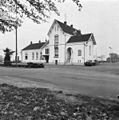Meuse line
| Nijmegen – Venlo Maas line |
|||||||||||||||||||||||||||||||||||||||||||||||||||||||||||||||||||||||||||||||||||||||||||||||||||||||||||||||||||||||||||||||||
|---|---|---|---|---|---|---|---|---|---|---|---|---|---|---|---|---|---|---|---|---|---|---|---|---|---|---|---|---|---|---|---|---|---|---|---|---|---|---|---|---|---|---|---|---|---|---|---|---|---|---|---|---|---|---|---|---|---|---|---|---|---|---|---|---|---|---|---|---|---|---|---|---|---|---|---|---|---|---|---|---|---|---|---|---|---|---|---|---|---|---|---|---|---|---|---|---|---|---|---|---|---|---|---|---|---|---|---|---|---|---|---|---|---|---|---|---|---|---|---|---|---|---|---|---|---|---|---|---|---|
|
A train near Holthees in the municipality of Boxmeer
| |||||||||||||||||||||||||||||||||||||||||||||||||||||||||||||||||||||||||||||||||||||||||||||||||||||||||||||||||||||||||||||||||
| Route length: | 61 km | ||||||||||||||||||||||||||||||||||||||||||||||||||||||||||||||||||||||||||||||||||||||||||||||||||||||||||||||||||||||||||||||||
| Gauge : | 1435 mm ( standard gauge ) | ||||||||||||||||||||||||||||||||||||||||||||||||||||||||||||||||||||||||||||||||||||||||||||||||||||||||||||||||||||||||||||||||
| Top speed: | 125 km / h | ||||||||||||||||||||||||||||||||||||||||||||||||||||||||||||||||||||||||||||||||||||||||||||||||||||||||||||||||||||||||||||||||
| Provinces: |
Gelderland , Limburg , Noord-Brabant |
||||||||||||||||||||||||||||||||||||||||||||||||||||||||||||||||||||||||||||||||||||||||||||||||||||||||||||||||||||||||||||||||
| course | |||||||||||||||||||||||||||||||||||||||||||||||||||||||||||||||||||||||||||||||||||||||||||||||||||||||||||||||||||||||||||||||||
|
|||||||||||||||||||||||||||||||||||||||||||||||||||||||||||||||||||||||||||||||||||||||||||||||||||||||||||||||||||||||||||||||||
The Maaslinie ( Dutch Maaslijn ; alternatively Heilige Lijn ) is a largely single-track, non-electrified railway line from Nijmegen to Venlo . The route to Eindhoven branches off at Blerick . On the section from Mook-Middelaar to Blerick, the line is single-track and double-tracked from Nijmegen to Mook Molenhoek and from Blerick to Venlo. The name Maaslinie is sometimes used to refer to the Nijmegen – Venlo – Roermond train service.
history
The construction of the line was decided by law of November 10, 1875 and carried out on behalf of the Dutch state. The line went into operation on June 1, 1883. The Maas line was operated by the state railways. In order to enable train crossings, stations were built every six kilometers. The embankment and the piers of the Maas bridge were specially designed to create the conditions for a later track extension. An additional track was built between Nijmegen and Mook Molenhoek in 1912. In the 1920s, coal was transported on the Maas line by freight trains to the north of the Netherlands and to Twente , although the new Eindhoven – Weert line had already been opened in 1913 . Long-distance trains continued to run on the route from Amsterdam via Amersfoort to South Limburg, Germany and Belgium. Plans by the Nederlandse Spoorwegen envisaged the electrification of the Maas line for 1951, but this did not happen. At the end of the 1980s, the line became part of the Rail 21 project . In this context, the line was to be electrified and extended over its entire length. Like many other plans for the project, those for the Maas line were not carried out. Until Veolia Transport took over passenger transport in 2006 , trains operated by the Nederlandse Spoorwegen operated on the route. Arriva has been operating the Maas line with regional trains since 2016 . The line is secured by the Dutch train control system ATB Nieuwe Generatie .
future
In the future, the Maas line is to be subjected to far-reaching measures and thus improved. The clients, the provinces of Gelderland, Limburg and Noord-Brabant as well as the Ministry of Infrastructures and Waterstaat , want to counteract the increasing passenger traffic and improve the reliability of the trains. As part of this project, the entire railway line is to be electrified, a new train station opened near Venlo and additional tracks laid. The overhead line should run over specially constructed piles and posts that should be between 60 and 70 meters apart. The diesel trains are then to be replaced by electric variants. The Grubbenvorst station, which was in operation between 1884 and 1935, is to be rebuilt. For financial reasons, however, the construction of the station will not take place for the time being. The tracks are to be extended in two places. On the one hand, the crossing lane at Cuijk is to be extended, while the track system between Venray and Tienray is to be doubled. In addition, four arches along the route are to be made more spacious so that the speed of the trains does not have to be reduced, and 20 level crossings are to be secured. Construction is expected to be completed in 2022 and will cost 164 million euros.
Route connections
The following lines operate on the Maas line in the 2019 annual timetable :
| Train type | Line course | frequency |
|---|---|---|
| Stoptrein ( Arriva ) | Nijmegen - Venray - Venlo - Roermond | every half hour |
| Stoptrein (Arriva) | Nijmegen - Venray | every half hour (does not run in the evenings and on weekends) |
Picture gallery
Web links
- Website of the Maaslinie project (Dutch)
- Spoorlijn Nijmegen – Venlo . In: martijnvanvulpen.nl (Dutch)
Individual evidence
- ↑ Everything about project de Maaslijn op speciale website. In: prorail.nl. ProRail , March 3, 2017, accessed March 12, 2019 (Dutch).
- ↑ Carlijn Kruidhof: 11 miljoen euro tekort bij opwaardering Maaslijn. In: SpoorPro. ProMedia Group, February 27, 2018, accessed March 13, 2019 (Dutch).










